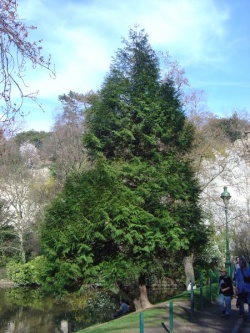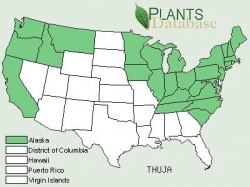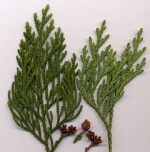Arborvitae
| Thuja |
|---|

|
| Scientific Classification |
|
| Species |
|

|
| Habitat Range |
Arborvitae are species of conifer trees belonging to the taxonomic genus Thuja. Then name arborvitae comes from the Latin word meaning "Tree of Life". People also sometimes refer to them as cedars because of the characteristics of their leaves, but they are not true cedars. These trees produce tiny, little cones that are barely even noticeable. One of the species in this genus, named the Western Redcedar is one of the largest and longest living trees on Earth. Since the leaves of these trees are full of vitamin C, they were at one time used as a cure for scurvy by European explorers and Native Americans.
Anatomy
Trees in the Genus Thuja have evergreen leaves that have little bumps that overlap each other, almost like scales. The leaf of a seedling instead of being scale-like, is like a needle. Every four rows of scale-like bumps, the branches of the twig split apart from the main one. These coniferous trees produce cones that are very tiny and unnoticeable. The male cones are very small in size and grow at the tips of the tree's twigs. The female cones also start out very small in size, like that of a males, but then grow larger in size up to 1-2 cm. Female cones are very tiny and brown. The wood is very light and soft; the wood also has many applications for it's nice characteristics. Because of its soft characteristics, it can be easily cut and carved. After the tree has died, it will lay there for a very long period of time because the decay rate is extremely slow.
Reproduction
The reproduction of a tree in the genus thuja is accomplished vegetatively, and sexually by seed. These trees can start reproducing as early as the age of six. Cones start to grow during the spring and start to open 7-10 days after the ripening of the cone. Seeds are carried and spread out through the wind, and land roughly around 150-200 ft from the parent tree. Germination starts to occur during daylight. In order for a seedling to grow it needs a little bit of sunlight and needs to be hydrated. The rate of growth for a seedling is very slow. The seeds germinate in the next upcoming spring. Vegetative reproduction occurs through a process called layering, and is responsible for most reproduction in Thuja.
Ecology
The distribution of the trees, classified under the genus thuja, are mostly located on the eastern or western coasts, or borderline Canada in North America. On the western side, they are extended all the way back to Montana and to the tip of southern California. On the eastern side, the trees are extended all the way to Minnesota and to the bottom of South Carolina. These trees like cool and moist weather and don't need much sun.
Gallery
Western redcedar
(Thuja plicata) trunkThuja occidentalis cones
Thuja sutchuenensis cones
References
- Thuja "Green Giant"by PlantsRus
- Thujaby Wikipedia
- PLANTS profile for Thujaby the United States Department of Agriculture






